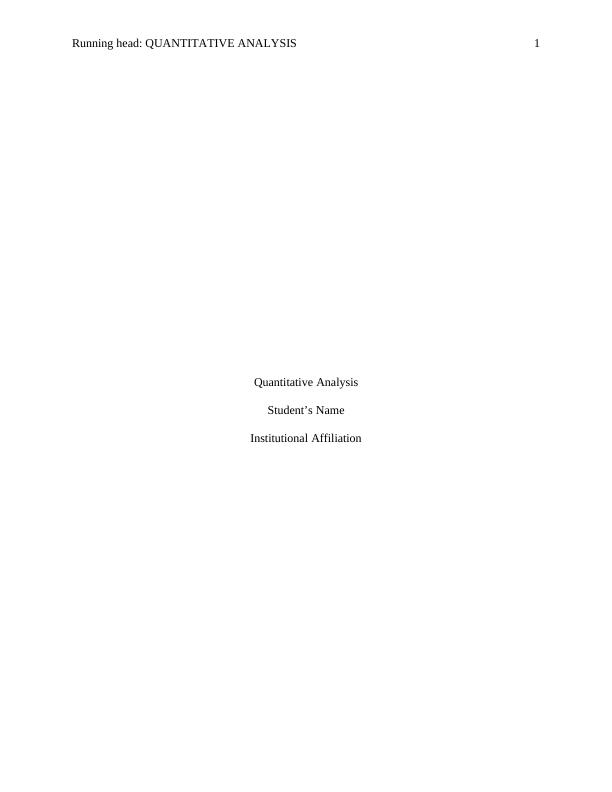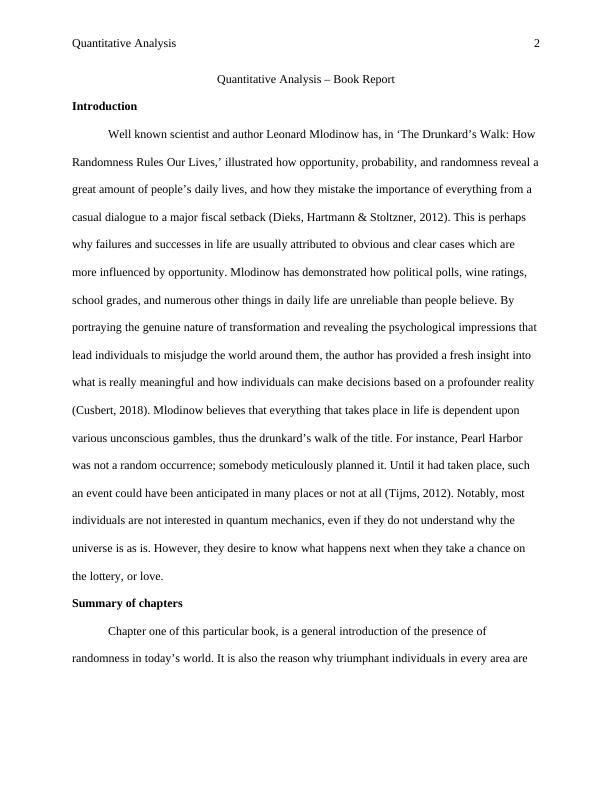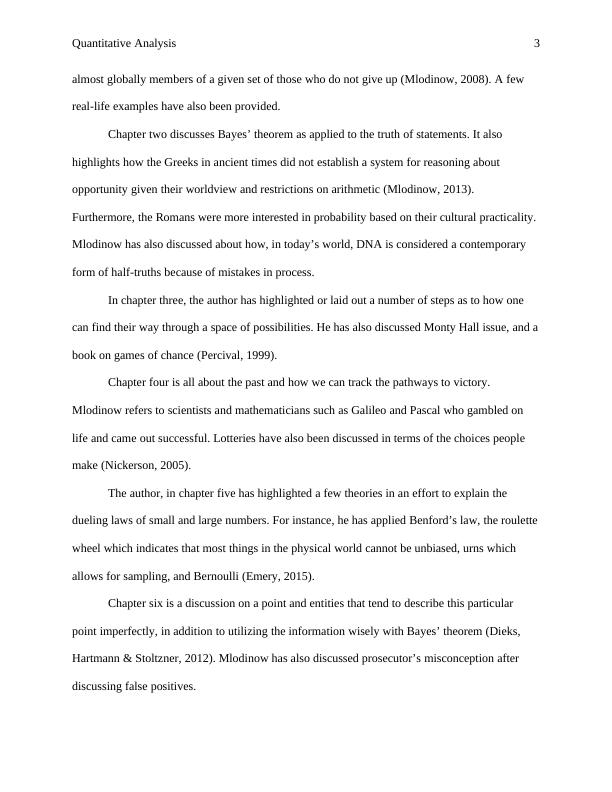Quantitative Analysis of The Drunkard’s Walk
6 Pages1285 Words23 Views
Added on 2021-06-15
Quantitative Analysis of The Drunkard’s Walk
Added on 2021-06-15
ShareRelated Documents
Running head: QUANTITATIVE ANALYSIS 1
Quantitative Analysis
Student’s Name
Institutional Affiliation
Quantitative Analysis
Student’s Name
Institutional Affiliation

Quantitative Analysis 2
Quantitative Analysis – Book Report
Introduction
Well known scientist and author Leonard Mlodinow has, in ‘The Drunkard’s Walk: How
Randomness Rules Our Lives,’ illustrated how opportunity, probability, and randomness reveal a
great amount of people’s daily lives, and how they mistake the importance of everything from a
casual dialogue to a major fiscal setback (Dieks, Hartmann & Stoltzner, 2012). This is perhaps
why failures and successes in life are usually attributed to obvious and clear cases which are
more influenced by opportunity. Mlodinow has demonstrated how political polls, wine ratings,
school grades, and numerous other things in daily life are unreliable than people believe. By
portraying the genuine nature of transformation and revealing the psychological impressions that
lead individuals to misjudge the world around them, the author has provided a fresh insight into
what is really meaningful and how individuals can make decisions based on a profounder reality
(Cusbert, 2018). Mlodinow believes that everything that takes place in life is dependent upon
various unconscious gambles, thus the drunkard’s walk of the title. For instance, Pearl Harbor
was not a random occurrence; somebody meticulously planned it. Until it had taken place, such
an event could have been anticipated in many places or not at all (Tijms, 2012). Notably, most
individuals are not interested in quantum mechanics, even if they do not understand why the
universe is as is. However, they desire to know what happens next when they take a chance on
the lottery, or love.
Summary of chapters
Chapter one of this particular book, is a general introduction of the presence of
randomness in today’s world. It is also the reason why triumphant individuals in every area are
Quantitative Analysis – Book Report
Introduction
Well known scientist and author Leonard Mlodinow has, in ‘The Drunkard’s Walk: How
Randomness Rules Our Lives,’ illustrated how opportunity, probability, and randomness reveal a
great amount of people’s daily lives, and how they mistake the importance of everything from a
casual dialogue to a major fiscal setback (Dieks, Hartmann & Stoltzner, 2012). This is perhaps
why failures and successes in life are usually attributed to obvious and clear cases which are
more influenced by opportunity. Mlodinow has demonstrated how political polls, wine ratings,
school grades, and numerous other things in daily life are unreliable than people believe. By
portraying the genuine nature of transformation and revealing the psychological impressions that
lead individuals to misjudge the world around them, the author has provided a fresh insight into
what is really meaningful and how individuals can make decisions based on a profounder reality
(Cusbert, 2018). Mlodinow believes that everything that takes place in life is dependent upon
various unconscious gambles, thus the drunkard’s walk of the title. For instance, Pearl Harbor
was not a random occurrence; somebody meticulously planned it. Until it had taken place, such
an event could have been anticipated in many places or not at all (Tijms, 2012). Notably, most
individuals are not interested in quantum mechanics, even if they do not understand why the
universe is as is. However, they desire to know what happens next when they take a chance on
the lottery, or love.
Summary of chapters
Chapter one of this particular book, is a general introduction of the presence of
randomness in today’s world. It is also the reason why triumphant individuals in every area are

Quantitative Analysis 3
almost globally members of a given set of those who do not give up (Mlodinow, 2008). A few
real-life examples have also been provided.
Chapter two discusses Bayes’ theorem as applied to the truth of statements. It also
highlights how the Greeks in ancient times did not establish a system for reasoning about
opportunity given their worldview and restrictions on arithmetic (Mlodinow, 2013).
Furthermore, the Romans were more interested in probability based on their cultural practicality.
Mlodinow has also discussed about how, in today’s world, DNA is considered a contemporary
form of half-truths because of mistakes in process.
In chapter three, the author has highlighted or laid out a number of steps as to how one
can find their way through a space of possibilities. He has also discussed Monty Hall issue, and a
book on games of chance (Percival, 1999).
Chapter four is all about the past and how we can track the pathways to victory.
Mlodinow refers to scientists and mathematicians such as Galileo and Pascal who gambled on
life and came out successful. Lotteries have also been discussed in terms of the choices people
make (Nickerson, 2005).
The author, in chapter five has highlighted a few theories in an effort to explain the
dueling laws of small and large numbers. For instance, he has applied Benford’s law, the roulette
wheel which indicates that most things in the physical world cannot be unbiased, urns which
allows for sampling, and Bernoulli (Emery, 2015).
Chapter six is a discussion on a point and entities that tend to describe this particular
point imperfectly, in addition to utilizing the information wisely with Bayes’ theorem (Dieks,
Hartmann & Stoltzner, 2012). Mlodinow has also discussed prosecutor’s misconception after
discussing false positives.
almost globally members of a given set of those who do not give up (Mlodinow, 2008). A few
real-life examples have also been provided.
Chapter two discusses Bayes’ theorem as applied to the truth of statements. It also
highlights how the Greeks in ancient times did not establish a system for reasoning about
opportunity given their worldview and restrictions on arithmetic (Mlodinow, 2013).
Furthermore, the Romans were more interested in probability based on their cultural practicality.
Mlodinow has also discussed about how, in today’s world, DNA is considered a contemporary
form of half-truths because of mistakes in process.
In chapter three, the author has highlighted or laid out a number of steps as to how one
can find their way through a space of possibilities. He has also discussed Monty Hall issue, and a
book on games of chance (Percival, 1999).
Chapter four is all about the past and how we can track the pathways to victory.
Mlodinow refers to scientists and mathematicians such as Galileo and Pascal who gambled on
life and came out successful. Lotteries have also been discussed in terms of the choices people
make (Nickerson, 2005).
The author, in chapter five has highlighted a few theories in an effort to explain the
dueling laws of small and large numbers. For instance, he has applied Benford’s law, the roulette
wheel which indicates that most things in the physical world cannot be unbiased, urns which
allows for sampling, and Bernoulli (Emery, 2015).
Chapter six is a discussion on a point and entities that tend to describe this particular
point imperfectly, in addition to utilizing the information wisely with Bayes’ theorem (Dieks,
Hartmann & Stoltzner, 2012). Mlodinow has also discussed prosecutor’s misconception after
discussing false positives.

End of preview
Want to access all the pages? Upload your documents or become a member.
Related Documents
Impact of Poverty and Unemployment on Child Development in Canadalg...
|7
|1804
|331
